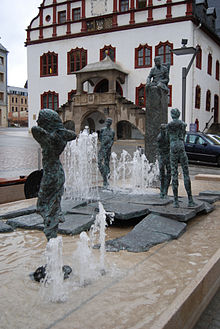King Albert Fountain
The König-Albert-Brunnen on the Altmarkt in Plauen is a work of art by the sculptor Norbert Marten , which was installed in 2007. It is one of the few contemporary fountains that relates to German history for exactly one hundred years (1907–2007). This work of " art in public space " preserves the cultural memory of the equestrian statue of King Albert through contemporary artistic representation for future generations. The fountain is located in the city center in the immediate vicinity of the historic Plauen town hall .
Background to the fountain
The Altmarkt in front of the historic town hall has always been Plauen's “parlor”. A mighty equestrian statue of King Albert of Saxony , inaugurated in 1907, adorned it. Markets were held here, people strolled here, and this was a local scene for both the political turmoil after the First World War and the unrest in the upheaval from the Weimar Republic to National Socialism .
The bombing at the end of the Second World War , which affected 75% of the city, survived the monument to King Albert undamaged. As a sign of a rich and proud bourgeois past, it defied the turmoil of history for a while and served the people of Plauen as a reminder of the familiar, now largely destroyed cityscape .
In the spring of 1946 the equestrian statue of King Albert on the Altmarkt was dismantled under dubious circumstances - probably on the initiative of the Soviet military administration . For many people from Plauen, this epoch was a situation without a hold. It seemed as if all cultural values were being lost.
Hans Löwel , who grew up in this city, is a good example for many people from Plauen . Later he achieved considerable wealth as a general agent for Plauen lace in the Federal Republic of Germany. His wife Edith, formerly Soubrette at the theater in Plauen, supported him in promoting art and culture in Plauen. The preservation of cultural values was very important to them. In the Hans-Löwel-Stiftung , Hans and Edith Löwel ordered a reminder of the equestrian statue of King Albert to be erected on Plauen's Altmarkt.
Therefore, the city of Plauen and the Hans-Löwel Foundation praised 2006 a nationwide design competition out. The design by Norbert Marten from Westerstede in Oldenburg was unanimously chosen for implementation by a competent, eleven-member jury .
On November 13, 2007, the fountain was ceremoniously handed over to its destination by the Lord Mayor of Oberdorfer. The fountain was financed by the Hans Löwel Foundation.
The fountain
In the style of the “King's Game” there is a kind of bronze chessboard on a granite fountain table on which four pieces are positioned. A kind of stage, played on by the bronze figures, leaves room for thought for the spectators' imagination and encourages improvisations for impromptu actors at the fountain.
Two kings, cast in bronze, stand outside the platforms to the right and left. They are seated figures, on a pedestal - as a sign of appreciation - at different heights. The larger king is defined as "King Albert" (height approx. 2.5 m). The other king shows a figure of identification that can be interpreted as Hans Löwel (height approx. 2 m).
From a relatively firmly structured chessboard shape on King Albert's side, individual parts emerge on the other side, form cracks, show bevels and edges down to individual fragments .
Water nozzles are built into the gaps and openings. By keeping individual nozzles closed, the power of other water jets increases and so keeping them closed becomes a playful experience of strength and power with their effects and interactions. Sometimes you get wet.
Gaps symbolize the time of war, the destruction of Plauen and the old King Albert monument .
Breaks and gaps also show the change in rigid structures, one could also call it the decline of outdated values. But the water supply also visualizes a renewal in the flow of time: hardened forms dissolve, new, flowing contents are formed.
Water as a refreshing energetic element pours from this platform onto the fountain table . From there it falls down on the front sides and is returned to the water cycle.
Fountains are arranged around the figure of King Albert on the fountain table . They give the royal figure a certain shelter out of respect and consideration. In the case of the sculpture of the other king, water flows out of the seat, from the property of Hans Löwel , so to speak, onto the fountain table and on to the old market in Plauen.
The “lady” in the royal game symbolizes the performing arts, a tribute to Edith Löwel, who was engaged in the theater in Plauen .
The bronzes were made by sand casting and lost wax casting . Sand casting was used for the kings and the platform; the smaller figures were prepared by the artist Norbert Marten for the bronze casting using the lost wax technique . Therefore, their surface is shaped more filigree. Under the fountain table there is a large well chamber in which, in addition to the water supply for the fountain, the technology for the fountains and the lighting has been integrated.
Coordinates: 50 ° 29 ′ 38.4 " N , 12 ° 8 ′ 9.2" E


